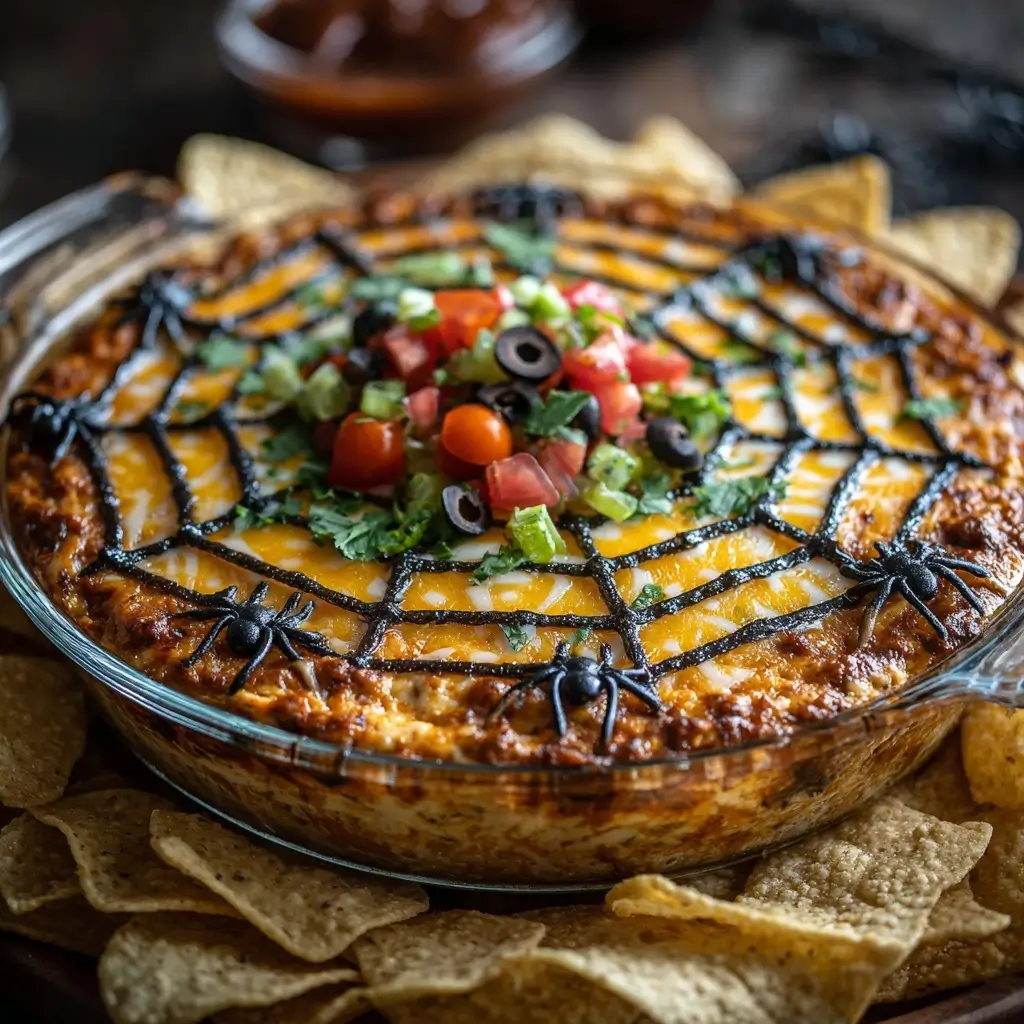Introduction
Welcome to the ultimate guide on creating the most eye-catching, crowd-pleasing appetizer for your next Halloween party or themed gathering—the Spiderweb Taco Dip! This vibrant and delicious dip is not only a feast for the taste buds but also a visual masterpiece that mimics a spooky spiderweb design. Perfectly layered with bold Mexican flavors and topped with an edible black olive web, this dip transforms a classic taco dip into a festive centerpiece. Whether you’re hosting kids, adults, or both, the Spiderweb Taco Dip is guaranteed to be the talk of the party. It’s easy to make, requires no cooking, and can be customized to suit various dietary needs. Let’s dive deep into everything you need to know to create this sensational dish.
The History
While traditional taco dips have been a staple at American potlucks, game-day parties, and family gatherings since the 1970s, the concept of the “Spiderweb Taco Dip” is a modern twist born out of seasonal creativity—specifically, Halloween-themed food trends. Taco dips themselves evolved from the popularity of Tex-Mex cuisine, combining ingredients like refried beans, sour cream, cheese, and salsa into a layered cold dip served with tortilla chips. As social media platforms like Pinterest and Instagram amplified food presentation aesthetics, hosts began experimenting with themed variations. The spiderweb version emerged as a popular October favorite, using sliced black olives arranged in a radial pattern over a white cheese base to mimic a spider’s web. This clever decoration adds a fun, spooky flair without altering the beloved flavor profile. Today, the Spiderweb Taco Dip symbolizes the fusion of tradition and creativity, making it a must-have for Halloween spreads across the country.
Ingredients Breakdown
The magic of the Spiderweb Taco Dip lies in its layers, each contributing distinct textures and flavors. Here’s a detailed breakdown of the key components:
- Refried Beans: Acts as the foundational layer, providing a savory, earthy base rich in protein and fiber. Opt for canned for convenience or homemade for a fresher taste.
- Guacamole or Avocado: A creamy, fresh layer that adds richness and healthy fats. You can use store-bought or make your own with ripe avocados, lime juice, cilantro, and onion.
- Sour Cream & Cream Cheese Mixture: Whipped together, these form the “canvas” for the spiderweb design. This smooth, tangy layer contrasts beautifully with the other ingredients.
- Cheddar Cheese (shredded): Adds a sharp, melty quality when sprinkled between layers. Use mild or sharp depending on your preference.
- Chopped Tomatoes: Bring freshness, color, and a juicy burst in every bite. Be sure to deseed them slightly to prevent the dip from becoming watery.
- Green Onions or Scallions: Provide a mild onion flavor and a pop of green, enhancing both taste and visual appeal.
- Sliced Black Olives: Essential for creating the spiderweb effect. Their dark color stands out against the light cheese layer, and their briny flavor complements the richness of the dip.
- Taco Seasoning: Infuses the sour cream layer with that classic taco flavor—cumin, garlic, paprika, and chili powder blend harmoniously.
- Tortilla Chips: The perfect sturdy vehicle for scooping. Choose thick restaurant-style chips to avoid breakage.
- Optional Add-ins: Jalapeños for heat, corn, black beans, lettuce, or even diced bell peppers for added crunch and nutrition.
Step-by-Step Recipe
- Prepare the Base Layer: Spread a can (16 oz) of refried beans evenly across the bottom of a 9×13 inch glass serving dish or a round pie plate for better web visibility. Smooth it out with the back of a spoon.
- Create the Guacamole Layer: Spoon about 1.5 cups of guacamole over the beans and spread gently to cover completely. If making your own, mash 2 ripe avocados with lime juice, salt, and chopped cilantro.
- Mix the Sour Cream Layer: In a bowl, combine 1 cup of sour cream with 8 oz of softened cream cheese. Add 1–2 tablespoons of taco seasoning (adjust to taste) and mix until smooth and fluffy. Spread this mixture evenly over the guacamole.
- Add Cheese: Sprinkle 1 cup of shredded cheddar cheese evenly over the sour cream layer.
- Layer Tomatoes: Distribute 1 cup of finely chopped tomatoes (drained of excess liquid) over the cheese.
- Scatter Green Onions: Sprinkle 1/4 cup of sliced green onions across the surface for color and flavor.
- Design the Spiderweb: Take pitted black olives and slice them thinly. Starting from the outer edge of the dip, place olive slices in a circular pattern. Then, using additional half-slices or whole rings, create radial lines from the center outward, forming a web. For precision, use toothpicks to guide placement.
- Garnish and Chill: Optionally add a few olive halves in the center to resemble spiders. Cover and refrigerate for at least 1 hour to allow flavors to meld and layers to set.
- Serve: Place around the perimeter of the dish with a bowl of tortilla chips. Encourage guests to scoop through all layers for the full flavor experience.
Tips
- Prevent Sogginess: Always drain excess liquid from tomatoes and guacamole. Patting them lightly with a paper towel helps maintain the dip’s structure.
- Use a Clear Dish: A transparent glass or acrylic dish allows guests to see all the colorful layers, enhancing presentation.
- Make Ahead: Assemble the dip up to 6 hours in advance. Add the olive spiderweb just before serving to keep it crisp and visually striking.
- Flavor Balance: Taste the seasoned sour cream mixture before spreading. Adjust seasoning with more chili powder, cumin, or a dash of hot sauce if desired.
- Chill Ingredients: Ensure all ingredients are cold before assembling to keep the dip firm and fresh, especially important if serving outdoors.
- Web Precision: Use a ruler or compass guide (lightly drawn on parchment beneath the dish) to space olive slices evenly for a symmetrical web.
- Chip Choice: Offer a variety of chips—tortilla, blue corn, or even baked versions—for different textures and dietary preferences.
Variations and Customizations
The Spiderweb Taco Dip is incredibly versatile. Here are some creative twists to suit different tastes and occasions:
- Vegetarian/Vegan Version: Use vegan refried beans, dairy-free sour cream and cheese, and avocado-based guacamole. Replace cream cheese with cashew cream for a plant-powered alternative.
- Meaty Twist: Brown 1/2 lb of ground beef or turkey with taco seasoning and layer it above the refried beans for a heartier dip.
- Spicy Kick: Mix diced jalapeños into the guacamole or sour cream layer. Add hot sauce or crushed red pepper flakes for extra heat.
- Colorful Layers: Incorporate corn, black beans, or diced bell peppers between layers for added texture and nutrition.
- Different Web Designs: Use roasted red peppers cut into thin strips for a red web, or create a ghostly white web with mozzarella pearls for a non-Halloween version.
- Mini Individual Dips: Make single servings in small mason jars or ramekins for portable party favors or lunchbox treats.
- Southwest Style: Swap taco seasoning for Southwest seasoning and include fire-roasted tomatoes and chipotle mayo for a smoky depth.
- Dessert Spiderweb Dip: Transform the concept into a sweet treat by using cream cheese, whipped topping, chocolate sauce, and graham cracker crumbs, with licorice laces forming the web.
Health Considerations and Nutritional Value
While undeniably delicious, the Spiderweb Taco Dip can be adapted for healthier eating. A standard serving (about 1/8 of the dish) contains approximately:
- Calories: 280–350 (depending on ingredients and portion size)
- Fat: 18–22g (mostly from cheese, sour cream, and avocado—healthy unsaturated fats included)
- Saturated Fat: 7–9g (can be reduced with low-fat dairy substitutes)
- Protein: 8–10g (from beans, cheese, and optional meat)
- Carbohydrates: 20–25g (primarily from beans and chips)
- Fiber: 5–7g (thanks to beans, avocado, and vegetables)
- Sodium: 600–900mg (can be high due to canned beans, cheese, and seasoning; opt for low-sodium versions where possible)
To make it healthier:
- Use low-fat or Greek yogurt instead of sour cream.
- Choose reduced-fat cheese or nutritional yeast for a cheesy flavor with less fat.
- Load up on fresh veggies like tomatoes, onions, and peppers to increase vitamins and antioxidants.
- Swap fried tortilla chips for baked, whole-grain, or vegetable sticks (like jicama or bell peppers).
- Limit portion sizes and serve with a side salad to balance the meal.
This dip offers a good source of plant-based protein, healthy fats from avocado, and essential nutrients like vitamin C, potassium, and folate—especially when loaded with vegetables.
Ingredients
- 1 (16 oz) can refried beans (vegetarian or regular)
- 1.5 cups guacamole (store-bought or homemade)
- 8 oz cream cheese, softened
- 1 cup sour cream
- 2 tablespoons taco seasoning (homemade or store-bought)
- 1 cup shredded cheddar cheese
- 1 cup chopped tomatoes, drained
- 1/4 cup sliced green onions
- 1 (2.25 oz) can sliced black olives, drained
- Tortilla chips, for serving
- (Optional) Ground beef or turkey, cooked and seasoned
- (Optional) Diced jalapeños, corn, black beans, or lettuce
Directions
- In a 9×13 inch dish or round serving platter, spread refried beans in an even layer.
- Top with guacamole, spreading carefully to cover the beans completely.
- In a medium bowl, beat cream cheese and sour cream until smooth. Mix in taco seasoning. Spread over guacamole.
- Sprinkle shredded cheddar cheese evenly over the sour cream layer.
- Add a layer of chopped tomatoes, followed by green onions.
- To create the spiderweb: Arrange black olive slices in concentric circles near the edges. Then place additional olive slices in straight lines radiating from the center to the edge, forming a web pattern. Use 6–8 radial lines for symmetry.
- (Optional) Place a few whole olive halves in the center to look like spiders.
- Cover and refrigerate for at least 1 hour before serving.
- Surround with tortilla chips and serve chilled.
FAQ
Q: Can I make the Spiderweb Taco Dip ahead of time?
A: Yes! Assemble the dip (without the olive web) up to 6 hours in advance. Add the olives just before serving to keep them from bleeding color and to maintain the web’s crisp appearance.
Q: How do I prevent the dip from getting watery?
A: Drain tomatoes well and pat them dry. Avoid overloading layers. Chilling the dip helps solidify the sour cream and cream cheese base.
Q: Can I freeze this dip?
A: Freezing is not recommended, as dairy and avocado do not freeze well and will separate upon thawing, ruining the texture.
Q: What can I use instead of black olives for the web?
A: Try roasted red pepper strips for a red web, or use thin strips of nori (seaweed) for a dramatic black contrast. For a fun twist, use black bean threads or even licorice lace for dessert versions.
Q: Is this dip suitable for vegetarians?
A: Yes, as long as you use vegetarian refried beans and skip any meat additions. Always check labels to ensure no animal lard is used.
Q: Can I make it gluten-free?
A: Absolutely. Most taco seasonings and ingredients are naturally gluten-free, but double-check labels. Serve with gluten-free tortilla chips.
Q: How long does it last in the fridge?
A: Store covered in the refrigerator for up to 3 days. The flavors often improve on day two, but the avocado may brown slightly. Press plastic wrap directly on the surface to minimize oxidation.
Summary
The Spiderweb Taco Dip is a festive, flavorful, and visually stunning appetizer that combines layers of refried beans, guacamole, seasoned sour cream, cheese, and fresh vegetables, crowned with an edible black olive spiderweb. Perfect for Halloween parties or any gathering, it’s easy to customize, feed-a-crowd friendly, and guaranteed to impress.










